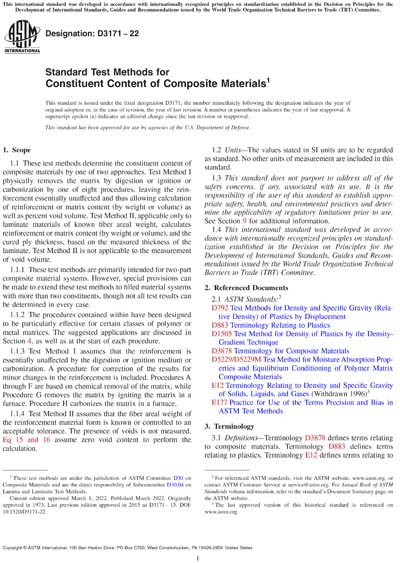Most recent
ASTM D3171-22
Standard Test Methods for Constituent Content of Composite Materials
1.1These test methods determine the constituent content of composite materials by one of two approaches. Test Method I physically removes the matrix by digestion or ignition or carbonization by one of eight procedures, leaving the reinforcement essentially unaffected and thus allowing calculation of reinforcement or matrix content (by weight or volume) as well as percent void volume. Test Method II, applicable only to laminate materials of known fiber areal weight, calculates reinforcement or matrix content (by weight or volume), and the cured ply thickness, based on the measured thickness of the laminate. Test Method II is not applicable to the measurement of void volume.
1.1.1These test methods are primarily intended for two-part composite material systems. However, special provisions can be made to extend these test methods to filled material systems with more than two constituents, though not all test results can be determined in every case.
1.1.2The procedures contained within have been designed to be particularly effective for certain classes of polymer or metal matrices. The suggested applications are discussed in Section 4, as well as at the start of each procedure.
1.1.3Test Method I assumes that the reinforcement is essentially unaffected by the digestion or ignition medium or carbonization. A procedure for correction of the results for minor changes in the reinforcement is included. Procedures A through F are based on chemical removal of the matrix, while Procedure G removes the matrix by igniting the matrix in a furnace. Procedure H carbonizes the matrix in a furnace.
1.1.4Test Method II assumes that the fiber areal weight of the reinforcement material form is known or controlled to an acceptable tolerance. The presence of voids is not measured. Eq 15 and 16 assume zero void content to perform the calculation.
1.2Units - The values stated in SI units are to be regarded as standard. No other units of measurement are included in this standard.
1.3This standard does not purport to address all of the safety concerns, if any, associated with its use. It is the responsibility of the user of this standard to establish appropriate safety, health, and environmental practices and determine the applicability of regulatory limitations prior to use. See Section 9 for additional information.
1.4This international standard was developed in accordance with internationally recognized principles on standardization established in the Decision on Principles for the Development of International Standards, Guides and Recommendations issued by the World Trade Organization Technical Barriers to Trade (TBT) Committee.
ASTM International [astm]

